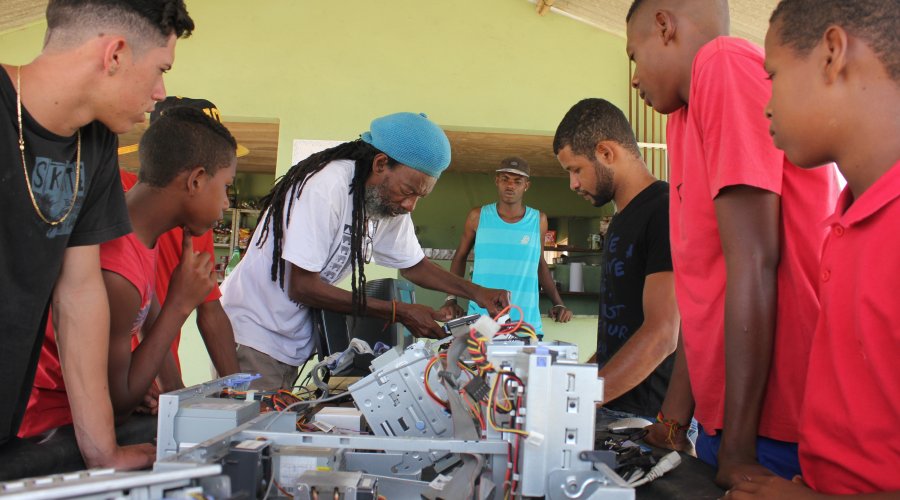The Baobab Route, after carrying out its activities in the Rio de Janeiro region in August, split into two teams during October - one visiting communities in Espírito Santo and Rio de Janeiro, while the other team installed internet antennas in the Kalunga territory of Goiás.
We left Campinas on October 4th, traveling 499km to Rio de Janeiro with an initial team of three people. We spent the night in Santa Teresa at Nay Mahim's house and continued the next morning to Vitória, ES, covering another 510 km. We arrived in Vitória around 8 PM and stayed at Casa da Barão, an autonomous cultural house where our partners PC, Luara, Sagás and Angélica (also members of the Mocambos Network) live.
The next morning, October 6th, we left Vitória towards São Matheus, now with six team members. After traveling 213km, we arrived in the afternoon at the Quilombo Divino Espírito Santo, where we spent three days conducting:
- Audiovisual production workshops
- Community discussion circles
- Computer maintenance workshops
- Presentations of Baobáxia
- Discussions about free digital territories
- Mapping, dance and graffiti workshops
The Quilombo Divino Espírito Santo is surrounded by eucalyptus plantations for cellulose production and daily oil extraction. Many hectares are reserved for eucalyptus, unlike the community which only has its houses and the association's territory. The community produces much Beiju (made from cassava gum), but due to a two-year drought, they can't grow enough cassava and must buy it externally, increasing the price of their beiju.
We left the community a baobab sapling that was planted and ritualized at the association. On the morning of October 9th, we traveled a few more kilometers to the Linha Rinho quilombo where we met Dona Miúda, a community leader. We spent the afternoon there, tried to connect some computers at the telecenter, and left another baobab sapling.
In the late afternoon we returned to Vitória, stopping again at Quilombo Divino Espírito Santo to see the planted baobab before continuing another 215 km from 7 PM. We arrived in Vitória around 11 PM and stayed there through October 10th, when a drum circle was held at Casa da Barão, where we met people from Vitória also connected to Black art and culture.
On October 11th, we left Vitória in the morning and went to Quissamã, RJ. There we found a large baobab tree estimated to be about 320 years old, then proceeded to the Machadinha Quilombo. Dalma, a teacher and resident, showed us around and shared stories. Machadinha is the only quilombo in Brazil where descendants still live in the adapted slave quarters (senzalas) where their ancestors were kept. Today about 300 families live in these adapted senzalas - Dona Dalma for example lives in the same senzala where her great-great-grandmother lived and raised her family.
In the mid-18th century, João Carneiro da Silva, diamond contractor for the Portuguese crown, acquired the lands of Fazenda Machadinha. In 1851 when João Carneiro died, the area was inherited by his nephew Manoel Carneiro da Silva (son of the Viscount of Araruama), who was married to the daughter of the Duke of Caxias. At that time, Fazenda Machadinha had up to 8,000 enslaved people. Today the community has only a small portion of land beyond the senzalas, insufficient even for a community garden. Surrounding the quilombo, many hectares belong to landowners growing sugarcane and raising cattle. Many quilombolas work harvesting sugarcane to survive.
The jongo tradition remains very strong in Machadinha Quilombo. In 2011, Jongo Dito Ribeiro from Campinas visited this quilombo and gave them a baobab sapling that had sprouted at Casa de Cultura Tainã and was planted in Machadinha. We saw this baobab now thriving in the quilombo's territory.
After getting to know the community, the route continued another 217 km to Rio de Janeiro. We arrived around 11 PM and spent the next day, October 12th, at Tenka Dara's house. On October 13th we traveled 300 km more to Quilombo do Campinho, where we left one of the prototype radio antennas previously used in Kalunga territory. On October 14th we traveled another 300km back to Campinas, arriving at 6 PM.

